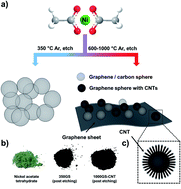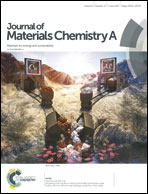Three dimensional hybrid multi-layered graphene–CNT catalyst supports via rapid thermal annealing of nickel acetate†
Abstract
Three-dimensionally structured graphitic materials are of interest for electrochemical applications as electrodes and catalyst supports. Many synthetic approaches to these materials require a preformed three-dimensional template and a carbon source, especially when highly crystalline materials are required. In this report, we utilise nickel acetate, which contains both a metal catalyst and a carbon source, as the sole component in the synthesis of both three-dimensional multi-layered carbon and graphene spherical structures (GS) and GS–carbon nanotube hybrid materials (GS–CNT), depending on the annealing procedure. By varying the synthesis conditions of these materials we are able to control the crystallinity of the structures. We show that the rapid introduction of the precursor into the hot zone is a key factor in the formation of the structures. This method demonstrates the utility of cheap metal salts as the sole component of the scalable synthesis of three-dimensional hybrid graphitic materials. We then utilise the novel materials as supports for platinum (Pt) nanocrystals produced using a thermal annealing approach and compare the effect of the carbon support on the active surface area and durability in cyclic voltammetry experiments.



 Please wait while we load your content...
Please wait while we load your content...